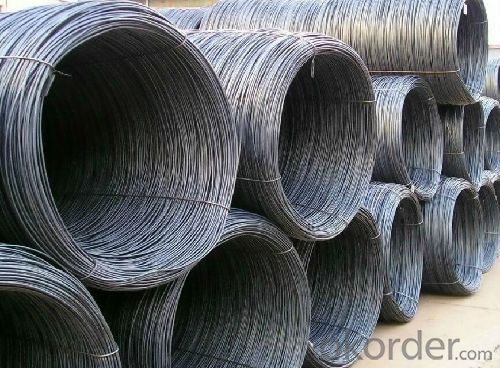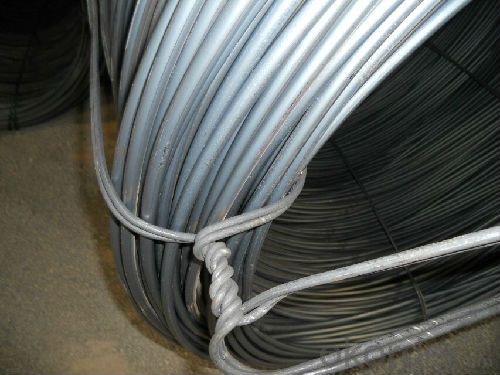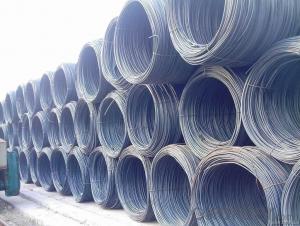Steel Wire Rod with Good Price in Different Materials
- Loading Port:
- Tianjin
- Payment Terms:
- TT or LC
- Min Order Qty:
- 30 m.t.
- Supply Capability:
- 20000 m.t./month
OKorder Service Pledge
OKorder Financial Service
You Might Also Like
Product Description of Steel Wire Rod with Good Price in Different Materials:
OKorder is offeringSteel Wire Rod with Good Price in Different Materials at great prices with worldwide shipping. Our supplier is a world-class manufacturer of steel, with our products utilized the world over. OKorder annually supplies products to African, South American and Asian markets. We provide quotations within 24 hours of receiving an inquiry and guarantee competitive prices.
Product Applications of Steel Wire Rod with Good Price in Different Materials:
Steel Wire Rod with Good Price in Different Materials are ideal for structural applications and are widely used in construction and manufacturing. Carbon steel wire rod is mainly used for reinforcement of reinforced concrete and welded structure or reprocessed (roberts , nail, etc.) materials, especially used to produce wire drawing, welding electrode, nails, spring, electronic, precise machinery parts and so on.
Product Advantages of Steel Wire Rod with Good Price in Different Materials:
OKorder's Steel Wire Rod with Good Price in Different Materials are durable, strong, and wide variety of sizes. They are newly produced by good quality steel billets.
Main Product Features of Steel Wire Rod with Good Price in Different Materials:
· Premium quality
· Prompt delivery & seaworthy packing (30 days after receiving deposit)
· Can be recycled and reused
· Mill test certification
· Professional Service
· Competitive pricing
Product Specifications of Steel Wire Rod with Good Price in Different Materials:
Steel Grade: SAE1006-1018B
Standard: ASTM, GB
Diameter: 5.5mm, 6.5mm, 7mm,8mm,9mm,10mm,12mm,14mm
Type: in coil, coil weight around 2MT
Alloy or Not: Alloy
Technique: Hot Rolled
Place of Origin: China Mainland
Surface: round, no twisted, light and smooth
FAQ of Steel Wire Rod with Good Price in Different Materials:
Q1: Why buy Hot Rolled Low Carbon Steel Wire Rods for Nails, Steel Wire Mesh from OKorder.com?
A1: All products offered byOKorder.com are carefully selected from China's most reliable manufacturing enterprises. Through its ISO certifications, OKorder.com adheres to the highest standards and a commitment to supply chain safety and customer satisfaction.
Q2: How do we guarantee the quality of our products?
A2: We have established an advanced quality management system which conducts strict quality tests at every step, from raw materials to the final product. At the same time, we provide extensive follow-up service assurances as required.
Q3: How soon can we receive the product after purchase?
A3: Within three days of placing an order, we will arrange production. The normal sizes with the normal grade can be produced within one month. The specific shipping date is dependent upon international and government factors, the delivery to international main port about 45-60days.
Pictures of Steel Wire Rod with Good Price in Different Materials



- Q:What are the different types of steel wire rod coatings used for increased ductility?
- There are several types of steel wire rod coatings used to enhance ductility, including zinc coating (galvanized), copper coating, and aluminum coating. These coatings provide a protective layer that helps prevent corrosion and improve the overall strength and flexibility of the wire rod.
- Q:How is steel wire rod used in the manufacturing of electrical conductors?
- Steel wire rod is used in the manufacturing of electrical conductors as it provides the necessary strength and flexibility required to transmit electricity efficiently. The wire rod is drawn into thin wires which are then insulated and used as the core of electrical cables. These conductors are widely used in power transmission lines, electrical wiring systems, and various electrical appliances to ensure the safe and reliable flow of electricity.
- Q:What are the different types of steel wire rod finishes available?
- There are several different types of steel wire rod finishes available, including bright finish, black finish, galvanized finish, and coated finish.
- Q:How does the carbon content affect the properties of steel wire rod?
- The carbon content in steel wire rod plays a significant role in determining its properties. Higher carbon content generally results in increased strength, hardness, and wear resistance of the wire rod. However, an excessive carbon content can also make the wire rod brittle, reducing its ductility and impact resistance. Therefore, finding the right balance of carbon content is crucial to achieve the desired combination of strength and flexibility in steel wire rod.
- Q:How is steel wire rod used in the production of tire reinforcement materials for motorcycles?
- Steel wire rod is used in the production of tire reinforcement materials for motorcycles as it provides strength and durability. The steel wire rod is typically woven into a mesh or used as individual strands, which are then incorporated into the tire's structure to enhance its structural integrity and resistance to punctures and impacts. This reinforcement ensures that the motorcycle tires maintain their shape, grip the road effectively, and provide a safe and reliable riding experience.
- Q:How is steel wire rod stored at the customer's site?
- Steel wire rod is typically stored at the customer's site in a variety of ways depending on the specific requirements and conditions. One common method is to store the steel wire rod on racks or pallets, especially if the customer has a large quantity of rods. These racks or pallets are usually placed in an organized manner to ensure easy accessibility and safety. In addition to racks or pallets, steel wire rod can also be stored in bundles or coils, particularly when the customer requires smaller quantities or wants to maintain the wire rod's shape and integrity. These bundles or coils are often secured with straps or bands to prevent any movement or damage during storage or transportation. Furthermore, the storage area for steel wire rod should be dry, clean, and well-ventilated to prevent corrosion or other forms of damage. Proper protection measures, such as covering the wire rod with tarps or plastic sheets, may be employed to shield it from dust, moisture, or other environmental elements. It is important for customers to follow any specific storage instructions provided by the manufacturer or supplier to ensure the longevity and quality of the steel wire rod. This may include guidelines on temperature control, stacking limitations, or the use of specialized equipment for handling and storage. Overall, the storage of steel wire rod at the customer's site should prioritize safety, accessibility, and protection to guarantee the optimal performance and usability of the product.
- Q:What are the different types of wire mesh filters made from steel wire rod?
- There are several different types of wire mesh filters that are made from steel wire rod. These filters are commonly used in various industries for applications such as filtration, sieving, and separation. One type of wire mesh filter made from steel wire rod is the plain weave filter. This type of filter is made by interweaving the steel wires in a simple over-and-under pattern. The resulting mesh is uniform and has a square-shaped opening. Plain weave filters are known for their strength and durability, making them suitable for heavy-duty applications. Another type of wire mesh filter is the twill weave filter. Twill weave filters are made by interlacing the steel wires in a pattern that creates a diagonal or herringbone-like appearance. This type of filter offers a tighter weave and a finer mesh compared to plain weave filters. Twill weave filters are commonly used in applications that require high precision and fine filtration. In addition to plain and twill weaves, there are also other types of wire mesh filters made from steel wire rod. These include Dutch weave filters, reverse Dutch weave filters, and welded wire mesh filters. Dutch weave filters have a coarser mesh with a greater number of wires in the weft direction, while reverse Dutch weave filters have a finer mesh with a greater number of wires in the warp direction. Welded wire mesh filters are made by welding the intersections of the steel wires, resulting in a stronger and more rigid mesh structure. Overall, the different types of wire mesh filters made from steel wire rod offer a range of options to suit various filtration needs. Whether it is for coarse or fine filtration, heavy-duty or precision applications, these filters provide efficient and reliable solutions.
- Q:What are the environmental considerations associated with steel wire rod production?
- Several environmental factors must be taken into account in the production of steel wire rods. One major concern is the energy consumption and greenhouse gas emissions associated with the manufacturing process. Typically, high temperatures required for steel wire rod production are achieved by burning fossil fuels like coal or natural gas, which releases carbon dioxide and contributes to climate change. Moreover, the extraction of raw materials for steel wire rod production, such as iron ore and coal, can have detrimental effects on the environment. Mining activities can lead to deforestation, destruction of habitats, and soil erosion. Additionally, the transportation of these raw materials to production facilities can result in further carbon emissions. Water usage is also a significant environmental consideration. Steel wire rod production necessitates large amounts of water for cooling and removing impurities. This can strain local water resources, especially in areas with limited availability or during droughts. Effective waste management is crucial in steel wire rod production. The process generates various by-products and waste materials, including slag and dust. Proper disposal or treatment of these waste materials is essential to prevent pollution of soil, water, and air. Furthermore, the use of chemicals and additives in steel wire rod production can have indirect environmental impacts. These substances may be utilized for corrosion prevention or enhancing mechanical properties. Poor handling or disposal of these chemicals can lead to environmental contamination. To address these environmental concerns, steel wire rod producers should invest in cleaner and more energy-efficient technologies, such as utilizing renewable energy sources or implementing energy-efficient furnaces. Additionally, recycling scrap steel instead of solely relying on virgin materials can significantly reduce the environmental impact. Implementing water conservation measures and developing comprehensive waste management plans are also crucial in minimizing the environmental footprint of this manufacturing process.
- Q:How is the corrosion resistance of steel wire rod evaluated?
- Various methods and tests are utilized to assess the corrosion resistance of steel wire rod. One commonly employed technique is the salt spray test, which is also known as the ASTM B117 test. During this test, the steel wire rod is exposed to a controlled environment of saltwater spray for a specific duration. Subsequently, the wire rod is inspected for any indications of corrosion, such as rust or discoloration. Another approach employed to evaluate corrosion resistance is the electrochemical test, such as the measurement of polarization curves. This test entails immersing the steel wire rod in an electrolyte solution and administering a small electric current. The resultant polarization curve provides information regarding the rate of corrosion and the propensity of the wire rod to corrode. Moreover, visual inspection and microscopic examination of the wire rod's surface can be conducted to identify any signs of corrosion, such as pitting or surface roughness. These evaluations are often supported by various corrosion measurement techniques, including analysis of weight loss, measurement of corrosion potential, and determination of corrosion rate. To summarize, the corrosion resistance of steel wire rod is evaluated through salt spray tests, electrochemical tests, visual inspection, and microscopic examination. These evaluations furnish valuable information about the wire rod's capacity to withstand corrosion and ensure its suitability for diverse applications.
- Q:What are the different ductility testing methods for steel wire rod?
- Steel wire rods can be assessed for ductility using various testing methods. These methods measure the material's ability to deform under tensile stress without breaking. Some commonly used tests for steel wire rods include: 1. Tensile Test: This is the most frequently employed method for evaluating ductility. It involves subjecting a wire rod specimen to increasing tensile force until it fractures. The elongation and reduction in area of the specimen are measured to determine its ductility. 2. Bend Test: This test assesses the material's ability to withstand bending without cracking or fracturing. A wire rod specimen is bent to a predetermined angle, and any visible defects or changes are documented to evaluate its ductility. 3. Cupping Test: This test determines the deep-drawing quality of steel wire rods. A specimen is deformed into a cup shape using a die and punch. The material's ability to undergo deformation without cracking or tearing indicates its ductility. 4. Charpy Impact Test: While primarily used for measuring toughness, this test also provides insights into the ductility of steel wire rods. A notched specimen is subjected to a high-velocity impact, and the energy absorbed during fracture is measured. Higher energy absorption suggests good ductility. 5. Fatigue Test: This test indirectly assesses the ductility of steel wire rods by evaluating their fatigue resistance. The specimen is subjected to repeated cyclic loading until failure, and the number of cycles required is recorded. Materials with high ductility are expected to have better fatigue resistance. These testing methods offer valuable information about the ductility properties of steel wire rods, aiding engineers and manufacturers in selecting the most suitable material for specific applications.
1. Manufacturer Overview |
|
|---|---|
| Location | |
| Year Established | |
| Annual Output Value | |
| Main Markets | |
| Company Certifications | |
2. Manufacturer Certificates |
|
|---|---|
| a) Certification Name | |
| Range | |
| Reference | |
| Validity Period | |
3. Manufacturer Capability |
|
|---|---|
| a)Trade Capacity | |
| Nearest Port | |
| Export Percentage | |
| No.of Employees in Trade Department | |
| Language Spoken: | |
| b)Factory Information | |
| Factory Size: | |
| No. of Production Lines | |
| Contract Manufacturing | |
| Product Price Range | |
Send your message to us
Steel Wire Rod with Good Price in Different Materials
- Loading Port:
- Tianjin
- Payment Terms:
- TT or LC
- Min Order Qty:
- 30 m.t.
- Supply Capability:
- 20000 m.t./month
OKorder Service Pledge
OKorder Financial Service
Similar products
New products
Hot products
Hot Searches
Related keywords



























